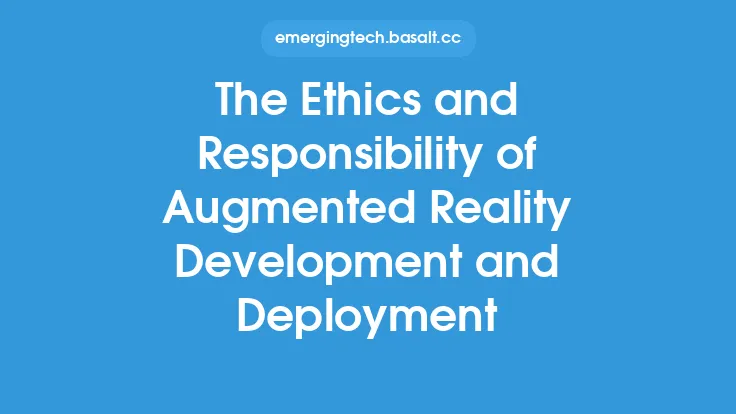Augmented reality (AR) has been gaining popularity in recent years, and its applications extend far beyond the gaming industry. In everyday life, AR can be used in a variety of ways to enhance our experiences, improve our productivity, and provide us with new and innovative ways to interact with the world around us. From virtual try-on to interactive manuals, AR is being used in a wide range of fields, including retail, education, and entertainment.
Introduction to Augmented Reality
Augmented reality is a technology that overlays digital information onto the real world, using a device's camera and display to blend the physical and virtual environments. This can be achieved through a variety of devices, including smartphones, tablets, smart glasses, and head-mounted displays. AR uses a combination of sensors, cameras, and software to detect the user's surroundings and superimpose virtual objects, information, and effects onto the real world. This technology has the potential to revolutionize the way we interact with the world around us, making it more interactive, engaging, and informative.
Applications of Augmented Reality in Everyday Life
One of the most significant benefits of AR is its ability to enhance our daily lives. For example, AR can be used to provide virtual instructions and guidance, making it easier to assemble furniture, cook recipes, or perform DIY tasks. AR can also be used to provide virtual try-on, allowing users to see how clothes, makeup, or accessories would look on them without having to physically try them on. Additionally, AR can be used to create interactive and immersive experiences, such as virtual tours, games, and entertainment. For instance, AR can be used to bring museum exhibits to life, providing users with a more engaging and interactive experience.
Technical Aspects of Augmented Reality
From a technical perspective, AR relies on a combination of hardware and software components to function. These include cameras, sensors, and displays, as well as software frameworks and tools for developing AR experiences. Some of the key technologies used in AR include computer vision, machine learning, and graphics rendering. Computer vision, for example, is used to detect and track the user's surroundings, while machine learning is used to recognize and respond to user input. Graphics rendering is used to generate the virtual objects and effects that are superimposed onto the real world. AR software frameworks, such as ARKit and ARCore, provide developers with the tools and resources they need to build AR experiences for a variety of platforms.
Augmented Reality in Retail and Marketing
AR is being increasingly used in retail and marketing to provide customers with a more immersive and engaging shopping experience. For example, AR can be used to create virtual product demonstrations, allowing customers to see how products work and what features they have. AR can also be used to provide virtual try-on, allowing customers to see how clothes, makeup, or accessories would look on them without having to physically try them on. Additionally, AR can be used to create interactive and immersive advertising experiences, such as virtual billboards and interactive displays. For instance, AR can be used to bring print ads to life, providing users with a more engaging and interactive experience.
Augmented Reality in Education and Training
AR is also being used in education and training to provide students with a more interactive and immersive learning experience. For example, AR can be used to create virtual labs and simulations, allowing students to conduct experiments and simulations in a safe and controlled environment. AR can also be used to provide virtual field trips, allowing students to explore and interact with historical sites, museums, and other cultural institutions. Additionally, AR can be used to create interactive and immersive training experiences, such as virtual tutorials and guides. For instance, AR can be used to provide medical students with a more interactive and immersive way to learn about human anatomy.
Future of Augmented Reality
As AR technology continues to evolve and improve, we can expect to see even more innovative and exciting applications in everyday life. For example, the development of smart glasses and other wearable devices is expected to make AR even more accessible and convenient. Additionally, the use of machine learning and artificial intelligence is expected to enable more sophisticated and interactive AR experiences. As AR becomes more widespread and mainstream, we can expect to see it being used in a wide range of fields, from entertainment and education to healthcare and marketing. With its potential to enhance our daily lives, improve our productivity, and provide us with new and innovative ways to interact with the world around us, AR is an exciting and rapidly evolving technology that is sure to have a significant impact on our lives in the years to come.





